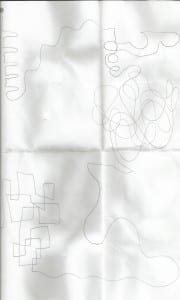I began improvisation with a bean bag surrounded by negativity for the practice, believing it to be just movement for movements sake.
Nine weeks later, I could not disagree with my first thoughts more.
Structures and modes of improvisations seems a small term when I consider how much I have learnt:
I can track mine and others movement, bringing moments back later on in a score. Or deviating away from them completely.
I can hone in on different parts of a score, pay attention to different things. The feel, the look, the sound that something makes.
I can experiment with different forms, The Underscore, Funktionen, Pop Up Scores, even my own.
I can play with space, I can stay away from the habitual and experiment with spatial limitations. Or play play with complete openness .
Time in choreography means you must dance for three minutes exactly. In improvisation I can go with or against what feels natural.
Pop Up Scores.
Components of the score are left down to chance. The random picking of a card.
3 Dancers
8 Minutes
Perform in the round
CD 2 Track 4
The audience will walk through the space.
Last week I noted that I would use Anna Halprin in understanding the audience/improviser relationship, that I would open my eyes and see the audience. This week, because of the in the round and audience walking through the space, I can do this. Whilst performing, I see the audience moving around different parts of the space or looking at me or the other performers at odd angels. Then I realise that this is what they find interesting. So at these moments in time, I track what is happening and find similar to ways to move or form developments of that, because I know that, that is what my audience want.
Music made an appearance this week, for the first time. It seems odd, especially when we have been performing in silence for so long. But I can understand why music has not come around sooner. In improvisation it is easy to be consumed by the music, to just go with it, following the rhythm or the feel. But this becomes tiresome and boring, especially if this music relationship remains the same. Period.
There is a lot more to learn about music and aural accompaniment when it comes to improvisation, I realise this from just touching upon it today. So I will pose these broad questions ‘How (in improvisation) can we use music beyond just going with it? Do we use similar music relationship concepts like we would in composition? If so, how do we do so?
The Jam.
Essentially the score was an open one.
Everyone would have a solo which would be happen in a chronological order, dictated a number chosen at random.
Music can be chosen at any time by picking cards.
Other components can be decided by a performer picking cards at anytime, these include movement and audience.
The first issue with this score was card picking. When a card was picked and announced to the audience and performers, it was difficult to hear due to the volume of the music. This would cause the performers to stop their movement and ask what the card said. This meant that the work lost what it had already established. From this it was difficult resume the score or pick up from where was left. It segmented the score and gave the feel that there was several scores within one.
I feel that in improvisation that I do not know how to use music, I noted this in our previous lesson. Music lead me to the habitual and literal. This is something that will only change when I know how to use the music. When I can answer the questions I posed earlier.
As a final note, it only seems fitting that I end this with the words of De Spain, the person I began this journey with.
“When you enter notice what you can, move however you want, honor those who have come before you, then forget it all and find your own path.” (De Spain, 2014, 173).
De Spain, K. (2014) Landscape of the Now. New York: Oxford University Press.
